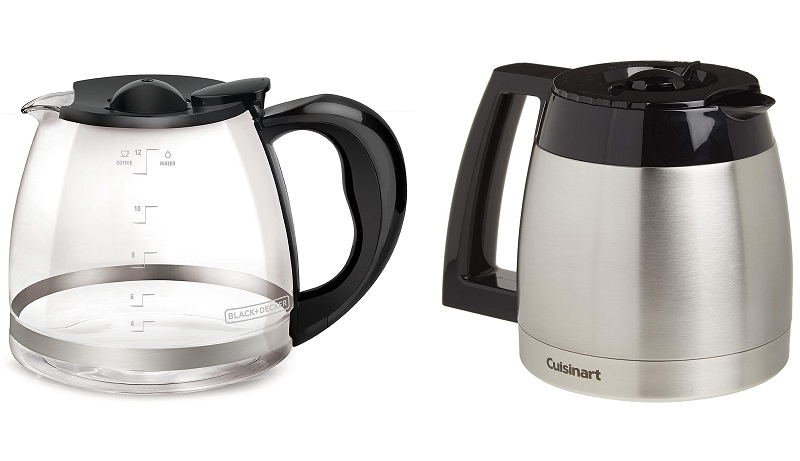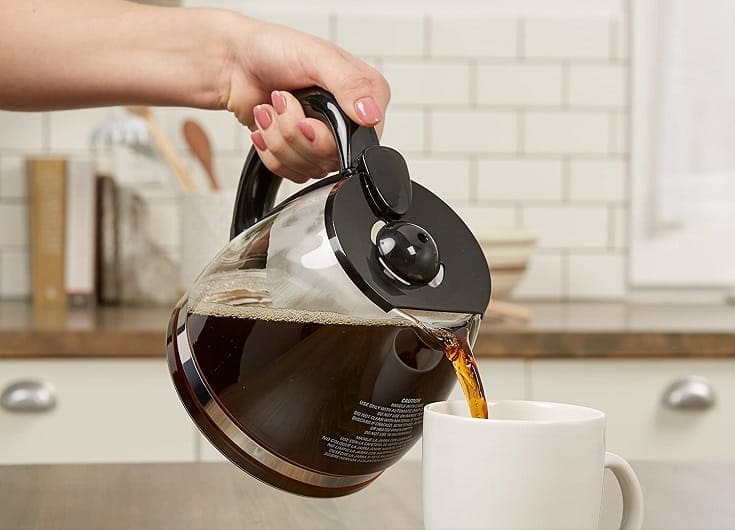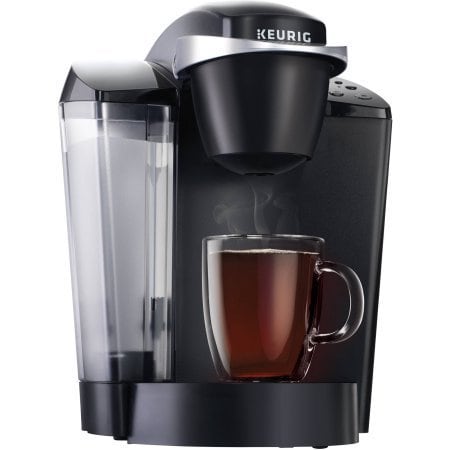
There comes a time when every good coffee maker reaches the end of its lifecycle and needs to be replaced. Even the most reliable and durable machines will eventually fail, and you’ll be faced with a decision: which coffee maker should I buy? This question is not a simple one, and we’ll leave the larger question for another article. In this guide, we’re going to discuss one important facet of buying a new coffee maker, one that is often overlooked…the carafe.
The type of carafe that comes with a coffee maker is not the first thing people think about when they start shopping for a machine. Carafes aren’t flashy and exciting, and they don’t come with buttons and knobs, so it might seem like they’re not important. In reality, choosing the right carafe is an important element that has a surprisingly large impact on your coffee-making experience. Whether you should choose a glass carafe or a thermal carafe depends on how you intend to use your coffee maker. In this head-to-head article, we’re going to put both glass and thermal carafes under the microscope and tell you everything you need to know to choose the right type of carafe for you. Let’s dig into the great thermal vs glass carafe debate!

What is a Coffee Carafe?
Before we start comparing the materials, let’s cover the most basic question: what is a coffee carafe? A coffee carafe is a pot that comes with many drip coffee makers. It is where the coffee brews into. You’ll probably see a handle, a lid, and a pouring spout, plus cup measure markings along the side. Coffee carafes can be made of different materials — hence this article — and maybe see-through or opaque. Though your coffee maker likely comes with a carafe, you can sometimes buy upgraded carafes to use instead.
Overview of Glass Carafes
Glass carafes are the most common kind of carafe and what most coffee makers come with. A glass carafe is exactly what you would think, a carafe made of glass. There are a few different kinds of glass that coffee maker carafes can be made of, but the vast majority are heat-resistant and shatterproof.
A common feature many countertop coffee makers have is a warming hot plate that sits under the pot to help keep your coffee hot for longer. We aren’t a big fan of these machines since hot plates tend to make coffee bitter if you leave the pot on them for too long. Still, they do keep coffee warm and are a nice feature to have if you’re the kind of coffee drinker that likes to make one pot and refill your mug throughout the morning.

Glass is a surprisingly common material for kitchen equipment, considering how fragile it is. One of the primary reasons for this is that glass doesn’t trap and hold tastes and scents like other materials. If you use your glass carafe to store pickle juice (we’re not sure why you would, but just go with it), the next time you make a pot of coffee, it won’t taste like pickles. That’s a silly example, but it gets the point across.
One last point to touch on is aesthetics. Glass carafes can have ornate designs and are better for formal gatherings where presentation is key. Thermal carafes don’t have this luxury and always look similar.
There isn’t much else to say about glass carafes. They’re simple, easy to clean, and ubiquitous. If you’re looking for an easy way to save money on a coffee maker, go with one that comes with a glass carafe.
- Cheaper than thermal carafes
- Glass doesn’t retain flavors and scents
- Prone to breaking
- Needs a hot plate to stay warm

Overview of Thermal Carafes
Thermal carafes are the second most common type of carafe and are generally found on more expensive machines. Most thermal carafes are made of stainless steel and are double-walled. The double-wall design is what lets thermal carafes keep your coffee warm for many hours without a heat source.
Commonly, thermal carafes will have a vacuum between the walls to help eliminate heat transfer between the inside of the carafe and the outside. This design was initially invented by Sir James Dewar, a Scottish chemist that needed a container to store cryogenic material and keep it cold. By isolating the interior contents of the container from its surroundings, heat can only escape via conduction through the parts of the inside wall that make contact with the outside wall. Since there are only a small number of contact points and because conduction is slow, heat transfer happens very slowly.

Double-walled vacuum carafes are the best containers for maintaining the temperature of their contents. If you’ve never used one, you’ll be shocked at how long they can keep your coffee hot. We regularly use a thermal carafe, and our coffee is still hot – not just warm– several hours after we brewed it.
Since thermal carafes are so adept at keeping coffee hot, machines that come with them usually don’t have hot plates since they’re not needed.
The only drawback to thermal carafes is that they tend to be significantly more expensive than their glass counterparts. We think the increased cost is more than worth it. Thermal carafes are unimaginably better at keeping coffee hot and also aren’t breakable like glass carafes. Once you purchase a thermal carafe, odds are you’ll never have to replace it.
How a carafe looks isn’t the most important factor to us but it is important to some people. In this regard, thermal carafes fall short. Almost all thermal carafes look like they’d be right at home in a laboratory or military installation. If you’re hosting a fancy dinner party, you’ll want an equally fancy carafe, and a glass carafe will always look nicer than a thermal one.
- Keeps coffee hot for many hours without an external heat source
- More durable than glass
- Coffee stays fresh and doesn’t become bitter
- More expensive than glass carafes
- Tend to be uglier than glass

Thermal vs Glass Carafes: Which is Right for You?
Setting
The most important factor to consider before choosing which carafe is best for you is the setting where you will use it. If you only make coffee for yourself and drink it all in one sitting, you’ll probably be happy saving money with a glass carafe.
On the other hand, if you live in a crowded house filled with coffee drinkers, you might be better served by a thermal carafe. If you make large pots of coffee and leave it for hours, refilling your mug as needed, a thermal carafe will be a revelation to you. Old coffee that’s been sitting in a glass carafe on a hot plate tastes bitter and burnt and leads to wasted coffee. Thermal carafes can keep coffee hot for longer without imparting any nasty flavors. If you regularly let your coffee sit in the pot, the only choice is a thermal carafe.
An office coffee station is another possible setting you might be purchasing a coffee machine for. We think that a thermal carafe is the better choice here, too, since coffee machines in offices tend to be used to brew large batches.
Price
If you’re still undecided between glass vs thermal carafes, the tiebreaking factor is the price. Thermal carafes are more expensive than glass carafes, so if you’re on a tight budget, it might not be feasible to get a machine with a thermal carafe. It’s not as simple as that, however, because glass carafes are more likely to break and need to be replaced. Over the course of a typical coffee machine’s lifespan, the total cost of multiple glass carafes is probably closer to the initial one-time cost of a thermal carafe than it might seem at first.

Conclusion
Thermal carafes are the clear winner, and the only reason not to buy one is if the price is your primary concern. Even then, glass carafes tend to break, and the costs of replacing them can add up over time. If you want a coffee pot that keeps your coffee hot for hours without an external heat source and without making it taste bitter and burnt, a thermal carafe is the only option.
RELATED READS:















